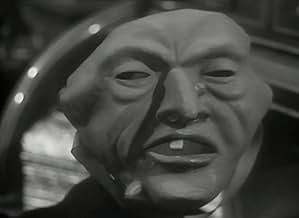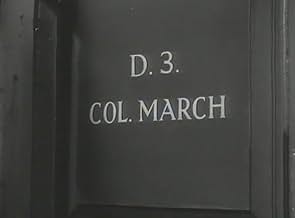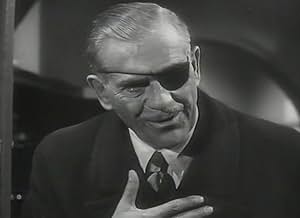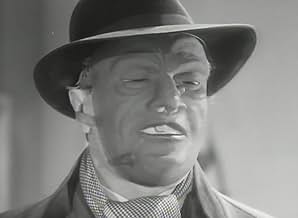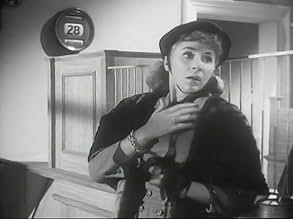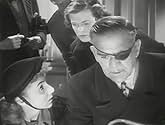Aggiungi una trama nella tua linguaThree episodes of "Colonel March of Scotland Yard" edited together for theatrical release.Three episodes of "Colonel March of Scotland Yard" edited together for theatrical release.Three episodes of "Colonel March of Scotland Yard" edited together for theatrical release.
Patricia Owens
- Betty Hartley
- (filmato d'archivio)
Dana Wynter
- Francine Rapport
- (as Dagmar Wynter)
Peter Butterworth
- Bank clerk
- (non citato nei titoli originali)
Cy Endfield
- Man leaving British Museum library
- (non citato nei titoli originali)
Pat Hagan
- Police Constable at Bank
- (non citato nei titoli originali)
Victor Harrington
- Customer in Bank
- (non citato nei titoli originali)
Recensioni in evidenza
Blacklisted Hollywood director Cy Endfield was given sanctuary at Nettlefold Studos in the early fifties by producer Hannah Weinstein directing these three pilot episodes for a TV series cobbled together into a rather hectic feature film starring a dashing-looking Boris Karloff sporting an eyepatch as he stumbled across a succession of bizarre crimes as John Dickson Carr's Colonel March of Scotland Yard.
(Years later, two of the cast, John Hewer and Sheila Burrell, became famous in add campaigns; John Hewer (now bearded) as Captain Birdseye and Sheila Burrell as the little old lady dismayed to discover her local bank is now "a trendy wine bar".)
(Years later, two of the cast, John Hewer and Sheila Burrell, became famous in add campaigns; John Hewer (now bearded) as Captain Birdseye and Sheila Burrell as the little old lady dismayed to discover her local bank is now "a trendy wine bar".)
Boris Karloff in the persona of the eyed-patched, erudite March, offers three mysteries from his office in Scotland Yard, the Bureau of Queer Complaints.
It's three episodes of what would become Colonel March of Scotland Yard, shot as pilots for the prospective series, and then strung together for theatrical release. The BBC was distinctly uninterested, until ITV was approved, whereupon the powers there decided they needed something to compete with the awful thing, whereupon they commissioned twenty-six episodes. Karloff is charming and intelligent, aspects he was rarely called upon to present in the movies, although they showed up in some of his television appearances. Stardom is just as confining as the typecasting of supporting players, and while Karloff the Object of Terror was something that could be sold to movie audiences based on his corpus of work, performances such as this would have confused them. It's a pity, because with the death of C. Aubrey Smith in 1948, this shows that Karloff could have taken over the role of the gruff but kindly, aristocratic exemplar of the Empire. But why pay the premium that Karloff commanded as a horror icon, only to confuse and upset the moviegoer?
It's three episodes of what would become Colonel March of Scotland Yard, shot as pilots for the prospective series, and then strung together for theatrical release. The BBC was distinctly uninterested, until ITV was approved, whereupon the powers there decided they needed something to compete with the awful thing, whereupon they commissioned twenty-six episodes. Karloff is charming and intelligent, aspects he was rarely called upon to present in the movies, although they showed up in some of his television appearances. Stardom is just as confining as the typecasting of supporting players, and while Karloff the Object of Terror was something that could be sold to movie audiences based on his corpus of work, performances such as this would have confused them. It's a pity, because with the death of C. Aubrey Smith in 1948, this shows that Karloff could have taken over the role of the gruff but kindly, aristocratic exemplar of the Empire. But why pay the premium that Karloff commanded as a horror icon, only to confuse and upset the moviegoer?
Boris Karloff heads a secret Scotland Yard dept (the Department of Queer Complaints - don't think they'd call it that today), which investigates mysteries - always crime, sometimes seemingly supernatural (a little like an early forerunner of Jonathan Creek). This movie contains three stories, edited together from the first three episodes of the Colonel March of Scotland Yard 1952 UK TV series, for a theatrical release; 'Hot Money', 'Death in the Dressing Room', and 'The New Invisible Man'. Nice to spot the old TV faces, Karloff is fun to watch as always, and the solutions are pretty clever. 6.5/10.
American-financed but shot in London, COLONEL MARCH OF Scotland YARD was a short-lived 1950s-era TV series starring Boris Karloff as a detective in charge of Department 3 at Scotland Yard - a department commonly nicknamed 'The Department of Queer Complaints'. It's a period-era X-FILES, with Karloff investigating various supernaturally-tinged crimes.
This film version is an anthology of three episodes from the show, all of them featuring a typically imposing Karloff as the eyepatch-sporting hero. It's always great to see the genial Karloff playing the hero for a change, and his gruff charm adds immeasurably to the pleasure of this otherwise rather ordinary little anthology. My main disappointment with COLONEL MARCH INVESTIGATES is that the supernatural stuff is kept distinctly limited in favour of the more ordinary explanation.
The first story, HOT MONEY, is about a bank robbery in which the loot vanishes; it's short and snappy, and worth seeing for Joan Sims, impossibly young and playing a lawyer's secretary. The second story, DEATH IN THE DRESSING ROOM, has some fun in the form of exotic dance and the atmospheric nightclub scenes, and features the lovely Dana Wynter alongside an on-form Richard Wattis, cast against type. The third story, THE NEW INVISIBLE MAN, sounds great but is in fact the least, a simple tale with a simple twist. Still, these are great fun for the era, and it's worth seeing for Karloff alone.
This film version is an anthology of three episodes from the show, all of them featuring a typically imposing Karloff as the eyepatch-sporting hero. It's always great to see the genial Karloff playing the hero for a change, and his gruff charm adds immeasurably to the pleasure of this otherwise rather ordinary little anthology. My main disappointment with COLONEL MARCH INVESTIGATES is that the supernatural stuff is kept distinctly limited in favour of the more ordinary explanation.
The first story, HOT MONEY, is about a bank robbery in which the loot vanishes; it's short and snappy, and worth seeing for Joan Sims, impossibly young and playing a lawyer's secretary. The second story, DEATH IN THE DRESSING ROOM, has some fun in the form of exotic dance and the atmospheric nightclub scenes, and features the lovely Dana Wynter alongside an on-form Richard Wattis, cast against type. The third story, THE NEW INVISIBLE MAN, sounds great but is in fact the least, a simple tale with a simple twist. Still, these are great fun for the era, and it's worth seeing for Karloff alone.
The master of the locked room mystery was, unarguably, John Dickson Carr, one of the most popular crime writers of the Golden Age. His masterpiece, The Hollow Man (1935), retains an almost legendary status among crime fiction fans, but he is now sadly forgotten by the wider public. The books have long been out of print in this country and I'm always hoping that some publisher will bring them back. Perhaps they are so obscure because Carr's most famous sleuths, Dr Gideon Fell and Sir Henry Merrivale, never made it to the screen. One of his lesser characters managed it, however, in the early 1950s, with the television series Colonel March of Scotland Yard.
Carr had used the character only once in his 1940 short story collection The Department of Queer Complaints, in which there is a subdivision of Scotland Yard that specialises in crimes of a curious or apparently impossible nature. The series was financed by the Americans and starred international film star Boris Karloff - most famous for playing the Chinese-American detective Mr Wong and, of course, Frankenstein's Monster. At this point in his long career, Karloff was a frequent guest on American radio series and even had his own show for children in which he read stories and told riddles. In 1952, he returned to England and made three episodes for ITV which acted as pilots for a longer series. Eventually, twenty six were produced, all of which were a brisk 25 minutes long.
The first three made were stitched together for release to cinemas in 1953. This was not uncommon for a TV show at the time and the practice would continue into the next decade, particularly with The Saint. Colonel March Investigates, then, is a taut 70 minute anthology of three slight, though entertaining, mysteries with the twinkly-eyed Karloff. He gives the character an eye-patch, which he didn't have in the stories, but it adds something to the character, as we can imagine he may have lost it in the First World War. This, perhaps, is someone who has witnessed untold horrors and has come to terms with the world by engaging with its more whimsical wonders.
Unsurprisingly, there is a framing device which helps tie the three tales together, in which March stands in his office and inspects a cupboard stocked with souvenirs of his cases before leading the audience into the corresponding story.
The first of these, aired as 'Hot Money', revolves around a bank robbery in which a clerk is incriminated. He follows the criminal to an office, where the money is seemingly stored. However, when the place is searched, the money has apparently disappeared. Despite the clerk being framed in the silliest of ways, the resolution is pretty decent, but nothing too special. Joan Sims appears here in an early role, and March reveals a John Steed-like umbrella sword!
The second story was aired as 'Death in the Dressing Room', which is probably the weakest of the three. Set in a nightclub, it features an exotic dance routine which acts as a clue, while the always reliable Richard Wattis plays the manager. The running time to these is so short that there is virtually no time to set up a number of suspects, so the culprit tends to be the person who has been in it the most. No matter, as it's all about how March gets his man, which he does here in a tense confrontation. As usual, March's sparring partner is the Scottish Inspector Ames (Ewan Roberts), though you wonder why he's there as March seems to be a famous genius.
The third story, intriguingly titled 'The New Invisible Man', features a peeping tom who has apparently witnessed a pair of animated gloves committing murder, and a scene of a crime with no evidence of a crime. It's the best one, I think, though there are a couple of problems. We get the opportunity to see the gloves in action ourselves, but it doesn't look much like the way it's shown to us in the reveal. The trick is good, nonetheless, and it certainly had me baffled. The reason behind it all is pretty shaky, however, and involves stolen paintings and, eventually, a kidnapped March. It's all good fun, though, which is what I'd call the film as a whole. And an interesting peek, as ever, into bygone England. It's just a pity the complete series isn't available.
Carr had used the character only once in his 1940 short story collection The Department of Queer Complaints, in which there is a subdivision of Scotland Yard that specialises in crimes of a curious or apparently impossible nature. The series was financed by the Americans and starred international film star Boris Karloff - most famous for playing the Chinese-American detective Mr Wong and, of course, Frankenstein's Monster. At this point in his long career, Karloff was a frequent guest on American radio series and even had his own show for children in which he read stories and told riddles. In 1952, he returned to England and made three episodes for ITV which acted as pilots for a longer series. Eventually, twenty six were produced, all of which were a brisk 25 minutes long.
The first three made were stitched together for release to cinemas in 1953. This was not uncommon for a TV show at the time and the practice would continue into the next decade, particularly with The Saint. Colonel March Investigates, then, is a taut 70 minute anthology of three slight, though entertaining, mysteries with the twinkly-eyed Karloff. He gives the character an eye-patch, which he didn't have in the stories, but it adds something to the character, as we can imagine he may have lost it in the First World War. This, perhaps, is someone who has witnessed untold horrors and has come to terms with the world by engaging with its more whimsical wonders.
Unsurprisingly, there is a framing device which helps tie the three tales together, in which March stands in his office and inspects a cupboard stocked with souvenirs of his cases before leading the audience into the corresponding story.
The first of these, aired as 'Hot Money', revolves around a bank robbery in which a clerk is incriminated. He follows the criminal to an office, where the money is seemingly stored. However, when the place is searched, the money has apparently disappeared. Despite the clerk being framed in the silliest of ways, the resolution is pretty decent, but nothing too special. Joan Sims appears here in an early role, and March reveals a John Steed-like umbrella sword!
The second story was aired as 'Death in the Dressing Room', which is probably the weakest of the three. Set in a nightclub, it features an exotic dance routine which acts as a clue, while the always reliable Richard Wattis plays the manager. The running time to these is so short that there is virtually no time to set up a number of suspects, so the culprit tends to be the person who has been in it the most. No matter, as it's all about how March gets his man, which he does here in a tense confrontation. As usual, March's sparring partner is the Scottish Inspector Ames (Ewan Roberts), though you wonder why he's there as March seems to be a famous genius.
The third story, intriguingly titled 'The New Invisible Man', features a peeping tom who has apparently witnessed a pair of animated gloves committing murder, and a scene of a crime with no evidence of a crime. It's the best one, I think, though there are a couple of problems. We get the opportunity to see the gloves in action ourselves, but it doesn't look much like the way it's shown to us in the reveal. The trick is good, nonetheless, and it certainly had me baffled. The reason behind it all is pretty shaky, however, and involves stolen paintings and, eventually, a kidnapped March. It's all good fun, though, which is what I'd call the film as a whole. And an interesting peek, as ever, into bygone England. It's just a pity the complete series isn't available.
Lo sapevi?
- QuizA pilot comprising three stories which would become episodes of the TV series 'Colonel March of Scotland Yard', filmed in the Autumn of 1952 at Nettlefold Studios: "Hot Money (1956)," "Death in the Dressing Room (1956)," and "The New Invisible Man (1956)."
- BlooperIn the final segment, 'The New Invisible Man', Major Rodman is kept in the police station. It is not clear who, therefore, has lit the fire in his sitting room, and kept it blazing all day.
- Citazioni
Insp. Ames: The radiator! Now why didn't I think of that?
Col. March: My dear Ames. Please don't embarrass us both by forcing me to answer that question.
- Curiosità sui creditiOpening credits prologue: LONDON
- ConnessioniEdited from Colonnello March (1954)
I più visti
Accedi per valutare e creare un elenco di titoli salvati per ottenere consigli personalizzati
Dettagli
- Data di uscita
- Paese di origine
- Lingua
- Celebre anche come
- The Department of Queer Complaints
- Luoghi delle riprese
- 140 Kings Road, Chelsea, Londra, Inghilterra, Regno Unito(exterior Barclays Bank)
- Azienda produttrice
- Vedi altri crediti dell’azienda su IMDbPro
- Tempo di esecuzione
- 1h 10min(70 min)
- Colore
- Proporzioni
- 1.37 : 1
Contribuisci a questa pagina
Suggerisci una modifica o aggiungi i contenuti mancanti


